




Click on Ad to See Larger Image
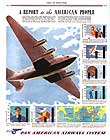 | 1941 PAA ad to communicate to the American public its role in the security of the country and its status as "America's Merchant Marine of the Air."
|
|


 They crouched in the excavation, watching the swarm of Japanese planes dive again and again on the nearby buildings, feeling the earth shake when the bombs exploded, ducking as debris and shrapnel rained down on them. They crouched in the excavation, watching the swarm of Japanese planes dive again and again on the nearby buildings, feeling the earth shake when the bombs exploded, ducking as debris and shrapnel rained down on them.
 It was unreal. Only two hours earlier, as the seven-man crew of Pan Am's Philippine Clipper, they had been on a routine flight to Guam. It was unreal. Only two hours earlier, as the seven-man crew of Pan Am's Philippine Clipper, they had been on a routine flight to Guam.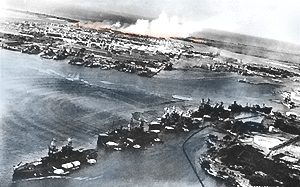 Then came the unexpected message: Then came the unexpected message:
JAPANESE ATTACKING PEARL HARBOR ... RETURN TO WAKE AT ONCE ... CLIPPER NEEDED FOR PATROL DUTY.
 Now they were watching with anger and frustration as Pan Am's Wake Island base was reduced to smoking rubble. Now they were watching with anger and frustration as Pan Am's Wake Island base was reduced to smoking rubble.
 Suddenly a Japanese fighter spotted the big Martin 130 flying boat tied to the dock. It was an easy target. Swooping down the plane open fire, raking the defenseless Clipper from nose to tail with machine gun bullets. Suddenly a Japanese fighter spotted the big Martin 130 flying boat tied to the dock. It was an easy target. Swooping down the plane open fire, raking the defenseless Clipper from nose to tail with machine gun bullets.
 In five minutes it was all over. The Japanese left as abruptly as they had come. Nine Pan Am base employees had been killed, all base facilities destroyed. Hurriedly the crew rounded up the rest of the Pan Am personnel who had been stationed there and loaded them onto the Clipper. They knew the Japanese would be back. Soon. In five minutes it was all over. The Japanese left as abruptly as they had come. Nine Pan Am base employees had been killed, all base facilities destroyed. Hurriedly the crew rounded up the rest of the Pan Am personnel who had been stationed there and loaded them onto the Clipper. They knew the Japanese would be back. Soon.
 Riddled with 96 bullet holes, the crippled and overloaded Philippine Clipper made two unsuccessful tries to take off, then on the third attempt managed to struggle into the air. Three days later, after stops at Midway and Honolulu, it was in San Francisco, where the crew gave one of the first eyewitness accounts of the Pacific War. Riddled with 96 bullet holes, the crippled and overloaded Philippine Clipper made two unsuccessful tries to take off, then on the third attempt managed to struggle into the air. Three days later, after stops at Midway and Honolulu, it was in San Francisco, where the crew gave one of the first eyewitness accounts of the Pacific War.
 Another Clipper didn't escape. Anchored in Hong Kong harbor on December 7 (December 8 Honk Kong time), fueled for a flight to Manila, it was hit by incendiary bullets from attacking Japanese fighters, caught fire, and burned to the water line. The Hong Kong Clipper II had only been in Pacific service for seven weeks. Another Clipper didn't escape. Anchored in Hong Kong harbor on December 7 (December 8 Honk Kong time), fueled for a flight to Manila, it was hit by incendiary bullets from attacking Japanese fighters, caught fire, and burned to the water line. The Hong Kong Clipper II had only been in Pacific service for seven weeks.
 A third Pan Am flying boat, the Pacific Clipper out of San Francisco, was on its way from New Caledonia to Auckland when it got the news of the Japanese attack. Deciding against trying to make it back over an ocean now patrolled by an enemy, it refueled in New Zealand and then headed west. Following a route close to the equator, it flew across Australia, India, the Middle East, across Africa and the South Atlantic, along the northern coast of South America and then on to New York. On the morning of January 6th, a startled officer in the control tower of New York's LaGuardia Airport heard on the loudspeaker: "Pacific Clipper, inbound from Auckland, New Zealand. Due arrive Pan American Marine Terminal at LaGuardia in seven minutes." The incredible month-long, 31,500-mile journey was the longest ever made by a commercial aircraft and the first around the world. The Pacific Clipper had flown over three oceans, made 18 stops in 12 different countries, and crossed the equator six times. A third Pan Am flying boat, the Pacific Clipper out of San Francisco, was on its way from New Caledonia to Auckland when it got the news of the Japanese attack. Deciding against trying to make it back over an ocean now patrolled by an enemy, it refueled in New Zealand and then headed west. Following a route close to the equator, it flew across Australia, India, the Middle East, across Africa and the South Atlantic, along the northern coast of South America and then on to New York. On the morning of January 6th, a startled officer in the control tower of New York's LaGuardia Airport heard on the loudspeaker: "Pacific Clipper, inbound from Auckland, New Zealand. Due arrive Pan American Marine Terminal at LaGuardia in seven minutes." The incredible month-long, 31,500-mile journey was the longest ever made by a commercial aircraft and the first around the world. The Pacific Clipper had flown over three oceans, made 18 stops in 12 different countries, and crossed the equator six times.
 Pan Am's experiences during the early days of World War II were unmatched by any other civil organization, but there was no time to dwell on them. With the entrance of the United States into the war, virtually all of Pan Am's equipment and personnel were assigned, directly or indirectly, to the war effort. Pan Am, the nation's only overseas airline, had a very special responsibility and it called on its 9,000 employees to respond. They rose to the challenge. Pan Am's experiences during the early days of World War II were unmatched by any other civil organization, but there was no time to dwell on them. With the entrance of the United States into the war, virtually all of Pan Am's equipment and personnel were assigned, directly or indirectly, to the war effort. Pan Am, the nation's only overseas airline, had a very special responsibility and it called on its 9,000 employees to respond. They rose to the challenge.
 Pan Am's pilots and navigators were called in to advise the military on the techniques of overseas flying and to start training crews. At the Pan Am Navigational School near Miami, General Jimmy Doolittle's navigators tranied for his bombing raid. At Pan Am bases, many departments started working around the clock. Doubling and tripling of maintenance personnel resulted in a 50 percent cut in servicing time and a 100 percent increase in aircraft utilization. Pan Am's pilots and navigators were called in to advise the military on the techniques of overseas flying and to start training crews. At the Pan Am Navigational School near Miami, General Jimmy Doolittle's navigators tranied for his bombing raid. At Pan Am bases, many departments started working around the clock. Doubling and tripling of maintenance personnel resulted in a 50 percent cut in servicing time and a 100 percent increase in aircraft utilization. 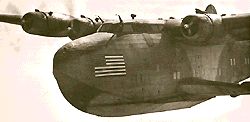 Most Clippers flew twice as many hours, twice as often as they had in peacetime. The plush interiors of the B-314 flying boats were stripped to wartime austerity and priority cargo was packed into every available inch of space. The exteriors were camouflaged by painting them with drab sea-gray paint. The Pan Am crews now wore khaki when under Army command and green when flying for the Navy. Most Clippers flew twice as many hours, twice as often as they had in peacetime. The plush interiors of the B-314 flying boats were stripped to wartime austerity and priority cargo was packed into every available inch of space. The exteriors were camouflaged by painting them with drab sea-gray paint. The Pan Am crews now wore khaki when under Army command and green when flying for the Navy.
 During the first year of the war records were shattered and reshattered. Feats that would have been considered miraculous in normal times were now all in a day's work. In 1942 Pan Am Clippers made 1,219 Atlantic crossings. The amount of cargo carried increased sharply—from 16,500 pounds in 1941 to over three million pounds in 1942! During the first year of the war records were shattered and reshattered. Feats that would have been considered miraculous in normal times were now all in a day's work. In 1942 Pan Am Clippers made 1,219 Atlantic crossings. The amount of cargo carried increased sharply—from 16,500 pounds in 1941 to over three million pounds in 1942!
 It seemed that transatlantic flight crews were in the air more than they were on the ground. It seemed that transatlantic flight crews were in the air more than they were on the ground. 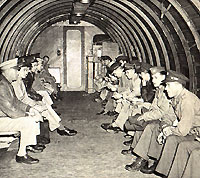 Captain H. E. Gray, who was to serve as president of Pan Am in the 1960's, made nine crossings in nine days. Pan Am pilot Joe Hart made 12 in 13 days. Captain R. O. D. Sullivan made a total of 103 crossings of the Atlantic in 1942. When he became the first person in history to make a hundred aerial crossings, he wasn't even aware of it. Bringing his oil-stained, camouflaged Clipper down on Long Island Sound, he had to be told of his achievement by Pan Am's ground personnel. Asked to describe his feelings at reaching this aviation milestone he answered, "Well, I do feel a little hungry." Captain H. E. Gray, who was to serve as president of Pan Am in the 1960's, made nine crossings in nine days. Pan Am pilot Joe Hart made 12 in 13 days. Captain R. O. D. Sullivan made a total of 103 crossings of the Atlantic in 1942. When he became the first person in history to make a hundred aerial crossings, he wasn't even aware of it. Bringing his oil-stained, camouflaged Clipper down on Long Island Sound, he had to be told of his achievement by Pan Am's ground personnel. Asked to describe his feelings at reaching this aviation milestone he answered, "Well, I do feel a little hungry."
 Although the Japanese had taken over all of its Central Pacific bases except Honolulu, Pan Am nevertheless continued to be active in Asia. Pan Am's affiliate on the mainland of China, the China National Aviation Corporation, made a heroic evacuation of some 275 U.S., British and Chinese civilians from Hong Kong, accomplished by pilots and ground crews working without rest for 72 straight hours. In April, 1942, Pan Am played a key role in evacuating more than 4,000 civilians and wounded soldiers from Burma, at the same time flying in supplies for the forces struggling to hold back the Japanese invaders-much of it accomplished in violent monsoon weather and under constant threats from enemy aircraft. Although the Japanese had taken over all of its Central Pacific bases except Honolulu, Pan Am nevertheless continued to be active in Asia. Pan Am's affiliate on the mainland of China, the China National Aviation Corporation, made a heroic evacuation of some 275 U.S., British and Chinese civilians from Hong Kong, accomplished by pilots and ground crews working without rest for 72 straight hours. In April, 1942, Pan Am played a key role in evacuating more than 4,000 civilians and wounded soldiers from Burma, at the same time flying in supplies for the forces struggling to hold back the Japanese invaders-much of it accomplished in violent monsoon weather and under constant threats from enemy aircraft.
 To expedite shipments to the Asian and African war zones, Pan Am formed a new Africa-Orient Division. Its exploits are legendary. The famous "Cannonball" route was established; stretching 11,500 miles from Miami to South America, across the Atlantic to Africa and from there to India, it was the longest, fastest, big-scale air transport route in history—and an important supply line for the entire Far East. At its peak, seven flights a day in each direction were being scheduled, and one day there were 16 Pan Am-operated C-54 transport planes over the ocean at the same time. This steady flow of arms, ammunition and supplies was later given a large share of the credit for driving the Japanese out of Burma. To expedite shipments to the Asian and African war zones, Pan Am formed a new Africa-Orient Division. Its exploits are legendary. The famous "Cannonball" route was established; stretching 11,500 miles from Miami to South America, across the Atlantic to Africa and from there to India, it was the longest, fastest, big-scale air transport route in history—and an important supply line for the entire Far East. At its peak, seven flights a day in each direction were being scheduled, and one day there were 16 Pan Am-operated C-54 transport planes over the ocean at the same time. This steady flow of arms, ammunition and supplies was later given a large share of the credit for driving the Japanese out of Burma.
 The Africa-Orient Division also flew supplies to China oner the Himalayas, a route known as the "Hump"—one of the wildest, most rugged areas on earth with the high mountain peaks and almost constantly turbulent weather. Frequently planes were forced to struggle up to 20,000 feet to clear the peaks, sometimes without oxygen for the crew, often fighting 100-mph winds. Violent updrafts and downdrafts tossed planes around like leaves. Ice was severe. The ever-present enemy fighters also took their toll. One Pan Am plane came back with over 3,000 bullet holes. For three years the flights over the "Hump" were the sole source of U.S. and other outside help to otherwise-isolated China. The Africa-Orient Division also flew supplies to China oner the Himalayas, a route known as the "Hump"—one of the wildest, most rugged areas on earth with the high mountain peaks and almost constantly turbulent weather. Frequently planes were forced to struggle up to 20,000 feet to clear the peaks, sometimes without oxygen for the crew, often fighting 100-mph winds. Violent updrafts and downdrafts tossed planes around like leaves. Ice was severe. The ever-present enemy fighters also took their toll. One Pan Am plane came back with over 3,000 bullet holes. For three years the flights over the "Hump" were the sole source of U.S. and other outside help to otherwise-isolated China.
 In addition to its regular flights across the Atlantic and the Pacific, and into Africa and the Orient, Pan Am allocated aircraft to special, often secret, missions. A Pan Am B-314 flew President Roosevelt and his advisors In addition to its regular flights across the Atlantic and the Pacific, and into Africa and the Orient, Pan Am allocated aircraft to special, often secret, missions. A Pan Am B-314 flew President Roosevelt and his advisors 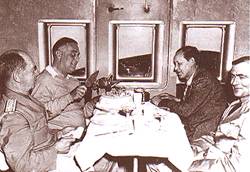
Franklin Roosevelt celebrated his sixty-first birthday aboard the Dixie Clipper on January 30th,1943 while over the Caribbean, on his return trip from his secret meeting in Casablanca with Winston Churchill and Charles De Gaulle.
|  |
to the summit conference at Casablanca. Other Pan Am aircraft carried top U.S. generals and admirals, Britain's Prime Minister Winston Churchill, the Netherland's Queen Wilhelmina, Greece's King George and scores of other high-ranking diplomats and military men. Pan Am flew more than 700 of these special missions.
 Although there were many acts of heroism and moments of high drama, Pan Am's major contribution throughout the war was doing what it had learned to do so expertly in peacetime: the building and outfitting of overseas air bases and the fast, dependable transportation of people and cargo over long distances. Although there were many acts of heroism and moments of high drama, Pan Am's major contribution throughout the war was doing what it had learned to do so expertly in peacetime: the building and outfitting of overseas air bases and the fast, dependable transportation of people and cargo over long distances.
 During the war years Pan Am built some 50 airports in 15 different countries, almost all of them in remote, often hostile areas. As the largest air transport contractor to the army and the navy, Pan Am flew over 90 million aircraft miles for the government During the war years Pan Am built some 50 airports in 15 different countries, almost all of them in remote, often hostile areas. As the largest air transport contractor to the army and the navy, Pan Am flew over 90 million aircraft miles for the government  | 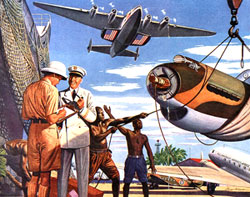
This advertising illustration from the Saturday Evening Post, November 22, 1941, shows workers unloading much-needed engines for use on military planes. |
and made more than 18,000 ocean crossings. In the first years of the war, before the operation was taken over by the U.S. Air Transport Command, it ferried 542 bombers and transports to the war zones. Pan Am also trained more then 5,000 military pilots and thousands of mechanics, and established schools and procedures for the training of many more thousands.
 And Pan Am paid the price: more then 200 employees gave their lives, an unknown number were imprisoned in enemy prison camps, at least a dozen aircraft were lost. And Pan Am paid the price: more then 200 employees gave their lives, an unknown number were imprisoned in enemy prison camps, at least a dozen aircraft were lost.
 Not many people know about Pan Am's role in World War II. There was almost no publicity. There were no medals, no glory. It was all done in the line of duty. Pan Am's Herculean efforts to keep supply lines open throughout the world was one of America's most valuable secret weapons. Not many people know about Pan Am's role in World War II. There was almost no publicity. There were no medals, no glory. It was all done in the line of duty. Pan Am's Herculean efforts to keep supply lines open throughout the world was one of America's most valuable secret weapons.
 When the war ended, Pan Am could look back with pride on a job well done. Its unique experience, gained during years of pioneering air transportation in Latin America and across the Atlantic and Pacific, had been the basis for the country's entire wartime international transport operations—and significantly influenced the war's outcome. When the war ended, Pan Am could look back with pride on a job well done. Its unique experience, gained during years of pioneering air transportation in Latin America and across the Atlantic and Pacific, had been the basis for the country's entire wartime international transport operations—and significantly influenced the war's outcome.

 |
|


Copyright © 1999-2004 Flying Clippers All Rights Reserved
All materials contained in http://www.flyingclippers.com are protected by copyright and trademark laws and may not be used for any purpose whatsoever other than private, non-commercial viewing purposes. Derivative works and other unauthorized copying or use of stills, video footage, text or graphics is expressly prohibited.
|
|




 Then came the unexpected message:
Then came the unexpected message: Most Clippers flew twice as many hours, twice as often as they had in peacetime. The plush interiors of the B-314 flying boats were stripped to wartime austerity and priority cargo was packed into every available inch of space. The exteriors were camouflaged by painting them with drab sea-gray paint. The Pan Am crews now wore khaki when under Army command and green when flying for the Navy.
Most Clippers flew twice as many hours, twice as often as they had in peacetime. The plush interiors of the B-314 flying boats were stripped to wartime austerity and priority cargo was packed into every available inch of space. The exteriors were camouflaged by painting them with drab sea-gray paint. The Pan Am crews now wore khaki when under Army command and green when flying for the Navy.
 Captain H. E. Gray, who was to serve as president of Pan Am in the 1960's, made nine crossings in nine days. Pan Am pilot Joe Hart made 12 in 13 days. Captain R. O. D. Sullivan made a total of 103 crossings of the Atlantic in 1942. When he became the first person in history to make a hundred aerial crossings, he wasn't even aware of it. Bringing his oil-stained, camouflaged Clipper down on Long Island Sound, he had to be told of his achievement by Pan Am's ground personnel. Asked to describe his feelings at reaching this aviation milestone he answered, "Well, I do feel a little hungry."
Captain H. E. Gray, who was to serve as president of Pan Am in the 1960's, made nine crossings in nine days. Pan Am pilot Joe Hart made 12 in 13 days. Captain R. O. D. Sullivan made a total of 103 crossings of the Atlantic in 1942. When he became the first person in history to make a hundred aerial crossings, he wasn't even aware of it. Bringing his oil-stained, camouflaged Clipper down on Long Island Sound, he had to be told of his achievement by Pan Am's ground personnel. Asked to describe his feelings at reaching this aviation milestone he answered, "Well, I do feel a little hungry."


